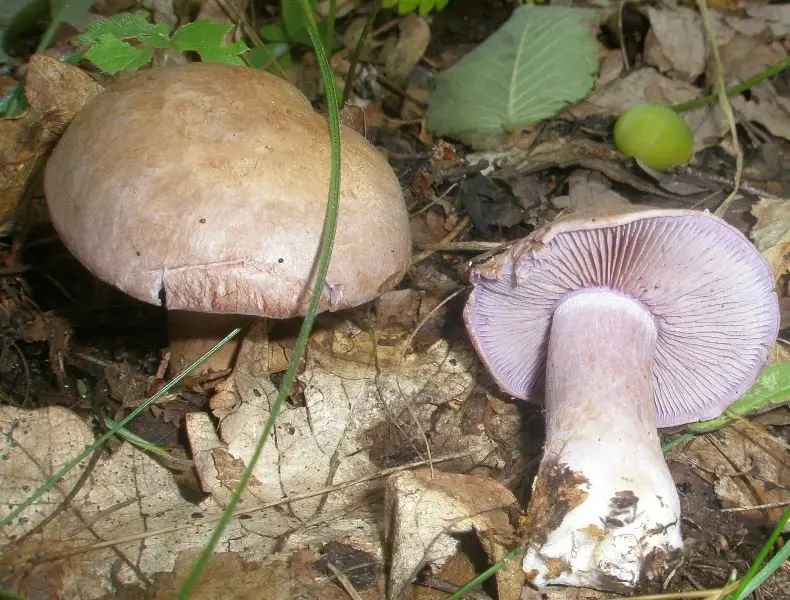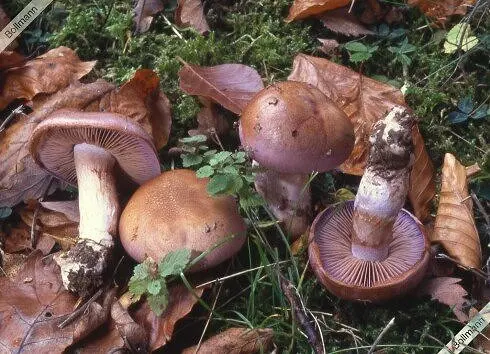Contents
Oak cobweb (Cortinarius nemorensis)
- Division: Basidiomycota (Basidiomycetes)
- Subdivision: Agaricomycotina (Agaricomycetes)
- Class: Agaricomycetes (Agaricomycetes)
- Subclass: Agaricomycetidae (Agaricomycetes)
- Order: Agaricales (Agaric or Lamellar)
- Family: Cortinariaceae (Spiderwebs)
- Genus: Cortinarius (Spiderweb)
- Type: Cortinarius nemorensis (Oak cobweb)
- A large phlegm;
- Phlegmatic nemorense.

Oak cobweb (Cortinarius nemorensis) is a fungus belonging to the genus Cobweb, the family Cobweb.
External Description
Cobweb oak (Cortinarius nemorensis) belongs to the number of agaric mushrooms, consisting of a stem and a hat. The surface of young fruiting bodies is covered with a webbed coverlet. The diameter of the cap of an adult mushroom is 5-13 cm; in young fruiting bodies, its shape is hemispherical, gradually becoming convex. With high humidity, the cap becomes wet and covered with mucus. When dried, the fibers are clearly visible on its surface. The surface of young fruiting bodies is colored in light purple hues, gradually becoming reddish-brown. A lilac hue is often noticeable along the edges of the cap.
Mushroom pulp is characterized by a whitish color, can rarely have a purple hue, has a slight unpleasant odor, and tastes fresh. Often, experienced mushroom pickers compare the smell of oak cobwebs with the aroma of dust. Upon contact with alkalis, the pulp of the described species changes its color to bright yellow.
The length of the stem of the fungus is 6-12 cm, and its diameter varies within 1.2-1.5 cm. In its lower part, it expands, and its surface in young mushrooms has a light purple tint, and in mature fruiting bodies it becomes brownish. On the surface, the remains of the bedspread are sometimes visible.
The hymenophore of this fungus is lamellar, consists of small plates with notches fused with the stem. They are located relatively often to each other, and in young mushrooms they have a light gray-violet color. In mature mushrooms, this shade of the plates is lost, turning into a brownish color. Spore powder consists of small particles 10.5-11 * 6-7 microns in size, the surface of which is covered with tiny warts.
Grebe season and habitat
The oak cobweb is widespread in the Eurasian zone and often grows in large groups, mainly in mixed or deciduous forests. It has the ability to form mycorrhiza with oaks and beeches. On the territory of Our Country, it is found in the Moscow region, Primorsky and Krasnodar regions. According to mycological studies, this type of fungus is rare, but widely distributed.

Edibility
Various sources interpret information about the edibility of the oak cobweb in different ways. Some mycologists claim that this species is inedible, while others speak of this type of mushroom as a little-studied, but edible mushroom. With the help of research, it was precisely determined that the composition of the fruiting bodies of the species described does not contain components toxic to the human body.
Similar types and differences from them
Cobweb oak belongs to the category of hard-to-distinguish fungi belonging to the subgroup Phlegmacium. The main similar species with it are:









